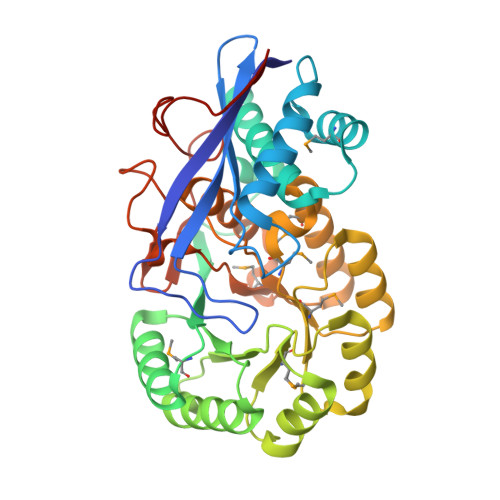Discovery of new enzymes and metabolic pathways by using structure and genome context.
Zhao, S., Kumar, R., Sakai, A., Vetting, M.W., Wood, B.M., Brown, S., Bonanno, J.B., Hillerich, B.S., Seidel, R.D., Babbitt, P.C., Almo, S.C., Sweedler, J.V., Gerlt, J.A., Cronan, J.E., Jacobson, M.P.(2013) Nature 502: 698-702
- PubMed: 24056934
- DOI: https://doi.org/10.1038/nature12576
- Primary Citation of Related Structures:
2PMQ, 4H2H - PubMed Abstract:
Assigning valid functions to proteins identified in genome projects is challenging: overprediction and database annotation errors are the principal concerns. We and others are developing computation-guided strategies for functional discovery with 'metabolite docking' to experimentally derived or homology-based three-dimensional structures. Bacterial metabolic pathways often are encoded by 'genome neighbourhoods' (gene clusters and/or operons), which can provide important clues for functional assignment. We recently demonstrated the synergy of docking and pathway context by 'predicting' the intermediates in the glycolytic pathway in Escherichia coli. Metabolite docking to multiple binding proteins and enzymes in the same pathway increases the reliability of in silico predictions of substrate specificities because the pathway intermediates are structurally similar. Here we report that structure-guided approaches for predicting the substrate specificities of several enzymes encoded by a bacterial gene cluster allowed the correct prediction of the in vitro activity of a structurally characterized enzyme of unknown function (PDB 2PMQ), 2-epimerization of trans-4-hydroxy-L-proline betaine (tHyp-B) and cis-4-hydroxy-D-proline betaine (cHyp-B), and also the correct identification of the catabolic pathway in which Hyp-B 2-epimerase participates. The substrate-liganded pose predicted by virtual library screening (docking) was confirmed experimentally. The enzymatic activities in the predicted pathway were confirmed by in vitro assays and genetic analyses; the intermediates were identified by metabolomics; and repression of the genes encoding the pathway by high salt concentrations was established by transcriptomics, confirming the osmolyte role of tHyp-B. This study establishes the utility of structure-guided functional predictions to enable the discovery of new metabolic pathways.
Organizational Affiliation:
1] Department of Pharmaceutical Chemistry, University of California, San Francisco, California 94143, USA [2].
















